Ketogenic diets have been used medically for at least 3000 years. It gained traction in allopathic medicine at the end of the 19th century and has been an accepted treatment for epilepsy since the 1920s.
In America, keto is reserved for a third line of epilepsy treatment after two different drugs have failed to control seizures, but it’s becoming increasingly popular thanks to organizations like The Charlie Foundation.
In the past century we’ve learned a lot about the mechanisms of ketosis and all that it can do. Research is beginning to demonstrate that, in addition to epilepsy, ketogenic diets can have benefits for those suffering from diabetes, Parkinson’s, Alzheimer’s, cancer, and more.
A therapeutic, medical ketogenic diet isn’t exactly the same as the nutritional keto that’s so popular for weight loss. Even within the category of medical keto are several different varieties of diet. Below is an overview of each type of medical keto diet and examples of how you would eat on each:
- Classic 4:1 Keto
- Classic 3:1 Keto
- Modified 2:1 Keto
- Modified 1:1 Keto [vegan example]
- Modified Atkins Diet [high-protein example]
- MCT-Based Keto
- Fasting
You might also want to skip to:
| Variation | Ratio (fat:protein+carbs) | % of calories from Fat | % of calories from Protein | % of calories from Carbs |
| Classic 4:1 Keto | 4:1 | 90% | 6% | 4% |
| Classic 3:1 Keto | 3:1 | 87% | 10% | 3% |
| Modified 2:1 Keto | 2:1 | 82% | 12% | 6% |
| Modified 1:1 Keto | 1:1 | 70% | 15% | 15% |
| Modified Atkins Diet (MAD) | N/A | 60%+ | Up to 35% | ~3-6% |
| MCT* Based | N/A | ~70-75% (40-50% from MCTs) | ~10% | ~15-20% |
| Fasting | N/A | 0% | 0% | 0% |
Classic 4:1 Keto Diet
The classic keto diet as designed in 1923 by Dr. Russell Wilder at the Mayo Clinic calls for a 4:1 ratio of fat to protein+carbs. That is, for every gram of protein and net carbohydrates consumed, 4 grams of fat are to be consumed (eg, 30g protein+10g net carbs=at least 160g fat).
Ideally, fat accounts for 90% of calories, protein for 6% and carbs for 4%.
4:1 Classic Keto Macro Amounts Based on Daily Calorie Needs
| Macros | 1200 Cal | 1600 Cal | 2000 Cal | 2400 Cal |
|---|---|---|---|---|
| Protein | 18g | 24g | 30g | 36g |
| net Carbs | 12g | 16g | 20g | 24g |
| Fat | 120g | 160g | 200g | 240g |
This is a challenging way to eat, I won’t lie. It’s probably for the best that ketosis dramatically reduces appetite. Staple foods are oils, butter, mayonnaise and heavy cream. Even bacon has too much protein to fit classic keto without the addition of much fat.
Sample 1-day meal plan for a classic 4:1 keto diet
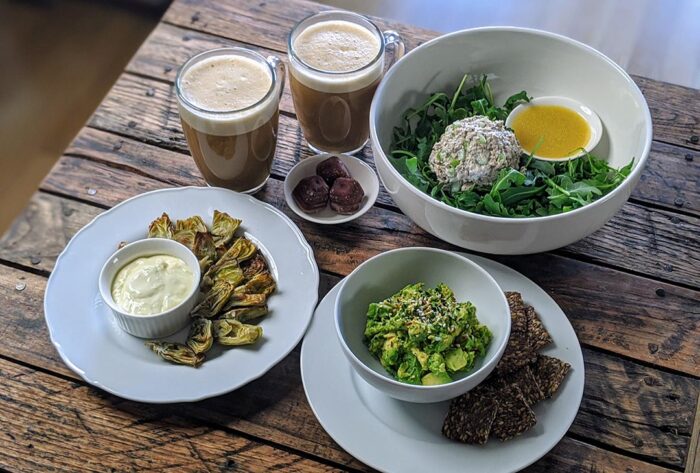
Here’s an example of how someone might eat while following a classic 4:1 keto diet:
- Two cups of creamy bulletproof coffee
- Ten flaxseed crackers and avocado mashed with either oil or mayonnaise and seasoned with Everything but the Bagel Seasoning
- Roasted artichoke hearts dipped in lemon-garlic aioli
- Sardine salad atop a bed of arugula dressed vinaigrette
- Chocolate-coconut fat bombs
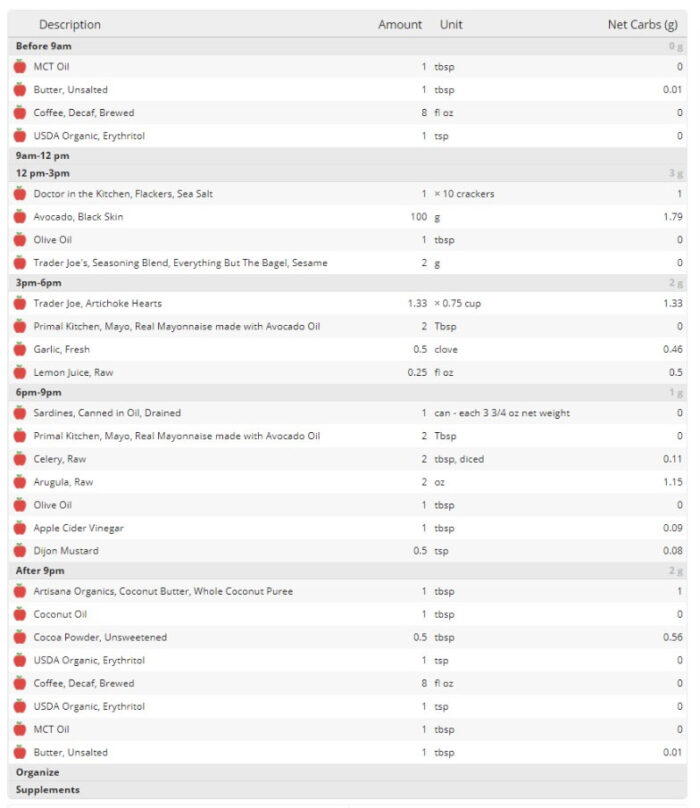
Keto ratio: 37.3g of protein + 8.1g carbs = 42g x 4 = at least 180g fat
[nutrition calories=”1895″ protein=”37.3″ carbs=”8.1″ fat=”189.4″ ]
Classic 3:1 Keto Diet
While a 4:1 ratio is considered the gold standard for medical keto, much of the literature allows for a 3:1 ratio. This more liberal interpretation is substantially easier to follow and allows for greater variety. I created the sample meal plan below as an example of how this diet can still work for someone with higher energy and protein needs.
Usually this comes to 87% of calories from fat, 10% from protein and 3% from carbs.
3:1 Classic Keto Macro Amounts Based on Daily Calorie Needs
| Macros | 1200 Cal | 1600 Cal | 2000 Cal | 2400 Cal |
|---|---|---|---|---|
| Protein | 30g | 40g | 50g | 60g |
| net Carbs | 9g | 12g | 15g | 18g |
| Fat | 116g | 155g | 193g | 232g |
Sample 1-day meal plan for a classic 3:1 keto diet

For example, a person following a 3:1 classic keto diet might eat:
- Bulletproof coffee
- Three strips of bacon and two eggs cooked in coconut oil with a side of avocado
- Broccoli cheese soup and salad with vinaigrette dressing
- Kelp noodles in pesto with kale, mushrooms and Parmesan cheese
- Chocolate-coconut fat bombs
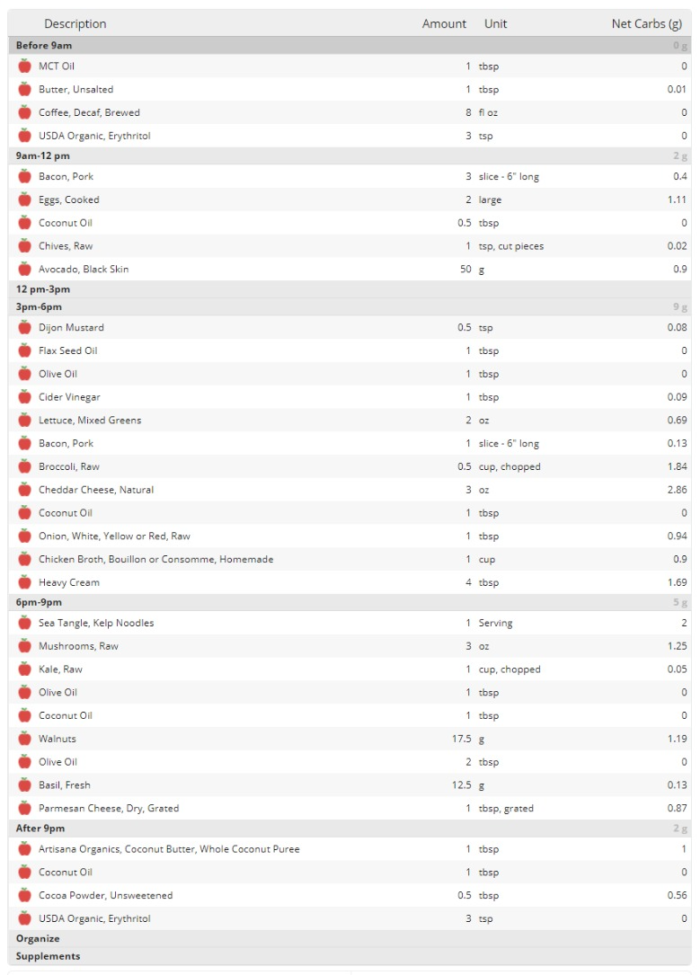
Keto ratio: 63g of protein + 19g carbs = 83g x 3 = at least 246g fat
[nutrition calories=”2550″ protein=”63.3″ carbs=”18.7″ fat=”248.3″ ]
Modified 2:1 Keto Diet
Keto can be modified to a 2:1 or even 1:1 ratio to make the diet easier to follow and allow for greater nutritional variety. Optimally, a 2:1 modified keto diet entails 82% of calories from fat, 12% from protein, and 6% from carbs – or at least, this is how its been studied.
2:1 Modified Keto Macro Amounts Based on Daily Calorie Needs
| Macros | 1200 Cal | 1600 Cal | 2000 Cal | 2400 Cal |
|---|---|---|---|---|
| Protein | 36g | 48g | 60g | 72g |
| net Carbs | 18g | 24g | 30g | 36g |
| Fat | 109g | 146g | 182g | 219g |
Sample 1-day meal plan for a 2:1 modified keto diet
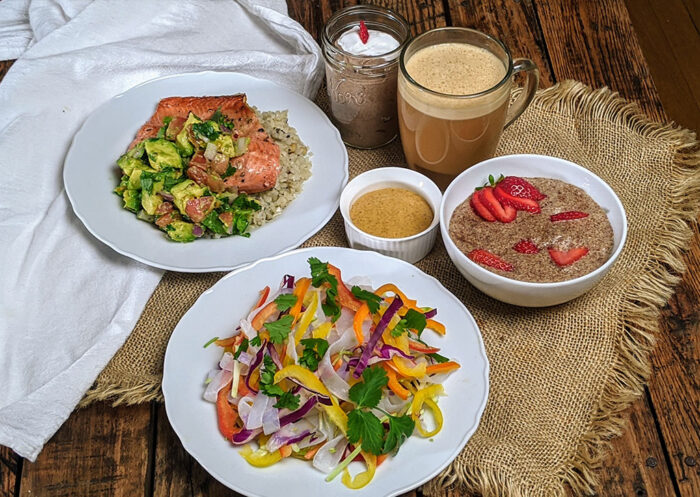
An example of how someone following a 2:1 modified keto diet might eat in a day is:
- Bulletproof coffee
- Flaxseed porridge with coconut milk and strawberry slices
- Noodle salad served with a variation of my favorite spicy Thai-style dressing
- Grilled salmon with avocado salsa served over cauliflower rice cooked in oil and butter
- Chocolate chia seed pudding with MCT oil
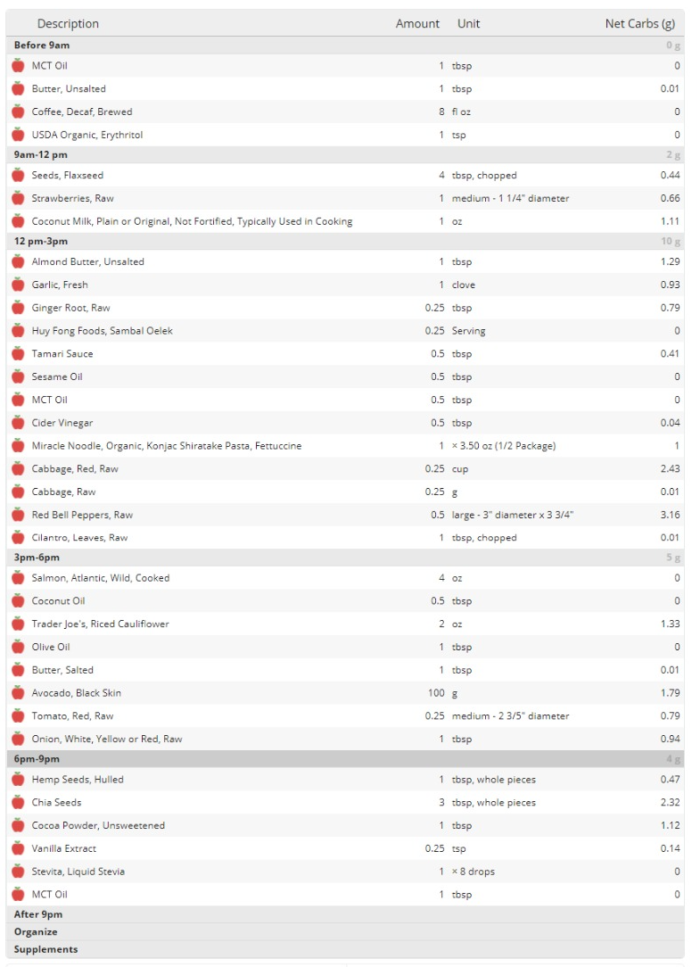
Keto ratio: 54g of protein + 21g carbs = 75g x 2 = at least 150g fat
[nutrition calories=”1710″ protein=”53.8″ carbs=”21.2″ fat=”150.8″ ]
Modified 1:1 Keto Diet
Most lenient yet is a modified 1:1 Keto Diet which calls for only one gram of fat for each gram of protein plus carbs combined.
The textbook balance for this version of keto allocates 70% of calories to fat, 15% to protein and 15% to net carbs allowing for a lot of wiggle room in the carbs and protein department, as you can see below.
1:1 Modified Keto Macro Amounts Based on Daily Calorie Needs
| Macros | 1200 Cal | 1600 Cal | 2000 Cal | 2400 Cal |
|---|---|---|---|---|
| Protein | 45g | 60g | 75g | 90g |
| net Carbs | 45g | 60g | 75g | 90g |
| Fat | 93g | 124g | 156g | 187g |
I, personally, am unable to maintain deep ketosis with a 1:1 ratio but some can, evidently.
Sample 1-day meal plan for a 1:1 modified keto diet – plants only edition
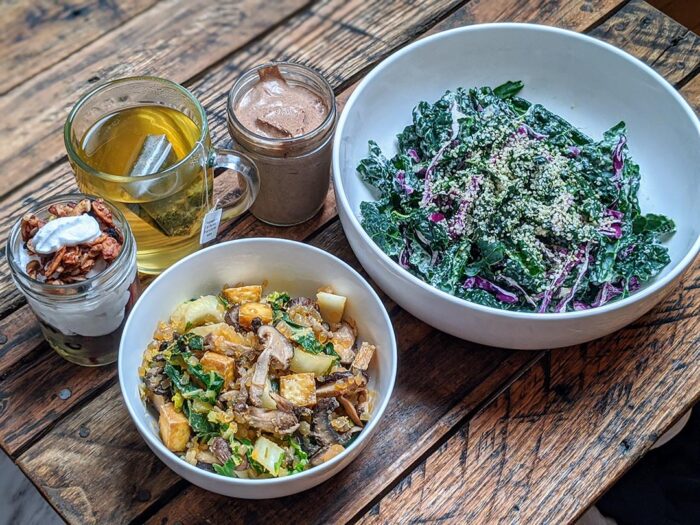
An example of how someone following a 1:1 modified keto diet without animal products might eat in a day is:
- Green tea
- Parfait of coconut milk yogurt, organic berries, and a sprinkle of keto nut granola
- Stir fry with bok choy, mushrooms, shirataki rice, and baked tofu
- Kale and red cabbage salad dressed with my favorite garlic-lemon-tahini dressing and topped with hemp seeds
- Chocolate chia seed pudding

Keto ratio: 47g of protein + 25g carbs = 72g x 1 = at least 72g fat. We have plenty more here – a 1.8:1 ratio, actually, but more fat is always fine.
[nutrition calories=”1544″ protein=”47.1″ carbs=”25.4″ fat=”131.7″ ]
Modified Atkins Diet (MAD) for Therapeutic Keto
The “Modified Atkins” style of medical keto is another way of thinking about the 1:1 or 2:1 modified keto diets. Rather than focus on ratios, the focus is on macro totals.
Like the Atkins diet, the Modified Atkins Diet (MAD) requires limiting daily net carbs to fewer than 20 grams or so. Some will find that they can eat substantially more than this amount while others must be more strict to remain in nutritional ketosis.
Whereas traditional Atkins allows for unlimited protein, however, those following medical keto will still need to monitor their protein to ensure it is no more or less than “adequate.” However, this is a great template for those with higher protein needs.
Also, while the traditional Atkins diet is often associated with artificial sweeteners and processed food, therapeutic keto generally requires whole foods.
This is the least restrictive therapeutic keto diet and the one that I personally follow. As long as I limit my carbs and monitor my protein, I can eat unlimited fat but am not required to eat a certain amount or a certain ratio. In fact, the meal plan above in the 1:1 example was designed using my individual MAD template (<35g net carbs, ~40g protein, unlimited fat).
I like MAD because it’s so scientific, individualized, and goal-focused. I know the protein and carbs limits to keep my Glucose-Ketone Index where I want it to be and eat accordingly.
Because of the flexibility, this can be the right choice for someone with higher protein needs. The sample below is also appropriate for the Modified Atkins Diet.
Sample Protein-heavy 1-day meal plan for a Modified Atkins keto diet
No pictures yet because I don’t eat mammals and Brad only cooks them up once a month or so.
An example of what someone with high protein needs might eat on the MAD is:
- Bulletproof coffee with collagen
- Bacon, eggs, and grilled tomatoes
- Tuna salad with avocado, pickles, and five flaxseed crackers
- Steak and Caesar salad with hard-boiled egg
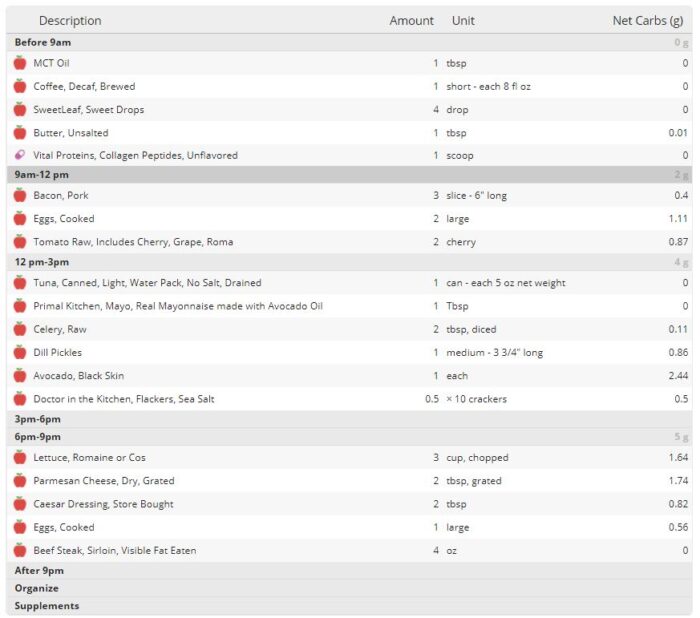
Keto Macros: Fewer than 20g of carbs is standard, 112g protein is “adequate” for those with higher protein needs, fat to satiety. You’ll notice that 11 grams (carbs) + 112 grams (protein) = 125 grams showing that this also fits a 1:1 ratio.
[nutrition calories=”1690″ protein=”111.9″ carbs=”11.1″ fat=”128.2″ ]
MCT-Based Keto Diet (MCTKD)
An MCT-based keto diet is a variation of modified keto, somewhere between a 2:1 and a 1:1, that derives half of all calories in the form of medium chain triglyceride fats (MCTs). MCTs, while naturally occurring in coconut and palm oils, are most readily available in MCT oil.
Because MCTs are more “ketogenic,” or more easily converted into ketones, this diet allows for a much larger percentage of calories from protein and carbohydrates.
Generally, MCT-based keto instructs for approximately 70-75% of calories come from fat (including the 50% from MCTs), 10% from protein and 15-20% from carbs.
MCT-Based Keto Macro Amounts Based on Daily Calorie Needs
| Macros | 1200 Cal | 1600 Cal | 2000 Cal | 2400 Cal |
|---|---|---|---|---|
| Protein | 30g | 40g | 50g | 60g |
| net Carbs | 45-60g | 60-80g | 75-100g | 90-120g |
| MCT Fat | 67g | 89g | 111g | 133g |
| Other Fat | 27-33g | 36-44g | 44-56g | 53-67g |
Such large amounts of MCTs allow for conventional indulgences like fruit or starch. In fact, after the first 50% of calories have been allocated to MCTs, the remaining 50% of calories are portioned fairly evenly – equal parts protein and fat, almost twice as many carbs.
If you’re considering this diet, keep in mind that MCTs can cause serious gastrointestinal distress like diarrhea and vomiting when consumed in these large amounts. It’s best to start with a teaspoon a day and build up slowly. But you’ll need to build up. It takes seven tablespoons of MCT oil to provide 98 grams of fat. That’s a lot.
MCT oil can also be expensive. And confusing.
MCTs (medium chain triglycerides) are made up of a glycerol molecule attached to three carbon tails. MCTs by definition are those with tails between 6-12 carbon molecules long. Anything shorter is a short chain triglycerides (SCT) and anything longer is a long chain triglyceride (LCT). The four types of MCTs are:
- C6 (Caproic acid or hexanoic acid) is the shortest MCT and metabolizes quickly. However, because of its unpleasant taste, it’s usually removed from commercial products.
- C8 (Caprylic acid or octanoic acid) is the most readily converted of the commercial MCTs into ketones by your liver. Studies have also found that it has anti-bacterial and anti-inflammatory properties.
- C10 (Capric acid or decanoic acid) is the second most readily converted to ketones. It’s been shown to be a powerful antifungal and possible immune booster.
- C12 (Lauric acid or dodecanoic acid) makes up about half of the fat in coconut and is a powerful antimicrobial. Some studies have also shown that it may reduce appetite.
For an MCT-based diet, you’ll get the most bang for your buck using an MCT oil with a higher percentage of C8 and C10.
This is the brand of organic MCT oil that I use. It’s 55% C8 and 37% C10.
Sample 1-day meal plan for an MCT-Based Keto Diet (MCTKD)
An example of what someone following an MCT-Based Diet could eat:
- Bulletproof coffee [MCT oil blended in]
- Acai smoothie bowl with strawberries and banana [MCT oil blended in]
- Smoke salmon atop mixed greens dressed with MCT-vinaigrette
- Indian-style curried vegetables [MCT oil mixed in]
- An apple
Notice that we’ve included foods that otherwise won’t fit into a keto diet such as banana and apple.
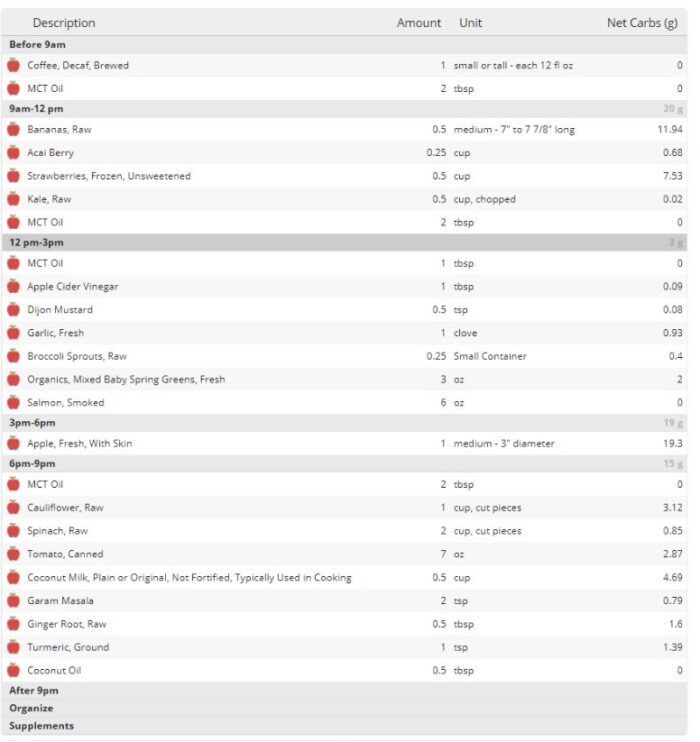
Keto Macros: 7 tablespoons (98 grams) of MCT oil account for 50% of the calories in this day’s eating. An addition 40g of fat are derived mostly from coconut oil, another rich source of MCTs. Ratio-wise, this meal plan is a 1:3:1 fat to carbs + protein ratio.
[nutrition calories=”1632″ protein=”44.5″ carbs=”58.3″ fat=”138.2″ ]
Fasting
Fasting was the original ketogenic diet and remains the most efficient way of achieving ketosis. Almost all adults will use up their stores of glycogen and start burning fat as the primary fuel after about 48 hours of water fasting. Here, fasting means ingesting nothing but water, black coffee, plain tea, physician-prescribed medication, and electrolytes, as needed.
Rapid-onset, deep ketosis is just one of the many benefits of fasting. Brad and I water fast from dinner Sunday until dinner Tuesday every week and extend until at least dinner Friday once a month. Click here to read more about how to fast and why.
Once in ketosis, it’s easy to maintain by eating a ketogenic diet as described above. Even better, you can make use of short cycles of fasting, or intermittent fasting, to deepen ketosis while eating a less restrictive diet. Common intermittent fasting rhythms are:
- 12/12 – limiting eating to only 12 hours a day, like 7am to 7pm
- 16/8 – limiting eating to an 8-hour feeding window, for example, 11am to 7pm
- 18/6 – eating only 6 hours a day, such as 1pm to 8pm
- 20/4 – I think you get the gist, this could be 8am to noon or 2pm to 6pm
- One Meal A Day (OMAD) – this usually equates to a 1- to 2-hour feeding window
- Alternate Day Fasting (ADF) – like it sounds, only eating every other day
- 36/12 – a variation on ADF, eating during a 12-hour window every other day
- 5/2 – fasting 2 days a week
The variations are endless and worth exploring to see what works best for you.
Water fasting means negligible micronutrients are ingested.
[nutrition calories=”0″ protein=”0″ carbs=”0″ fat=”0″]
Like all diets, fasting should undertaken with your doctor’s supervision.
How to decide what kind of keto to follow?
Keto can be confusing enough and all these extra versions can make it even more complex.
Generally, you should aim for the least restrictive diet that lets you achieve your goals whether your goal is seizure control, a low glucose-ketone index for cancer management, diabetes management or something else.
If that goal is urgent and critical, like seizure control, I would start with fasting and slowly adapt down through 4:1, 3:1, 2:1, etc, pausing to ensure your goal is met at each level.
If your goal is less urgent, such as weight loss or acne, you may prefer to start slowly by first eliminating processed food and sugar, then adopting a whole food, low carb diet before wading into ketosis with a Modified Atkins Diet.
A less restrictive diet means you’re more likely to stick to it. There are some times this doesn’t matter, however. Dietary variety may not matter for young children or people on a feeding tube. Those may be cases to default to a stricter brand of keto, based medical guidance. There are several options for prepared ketogenic formulas made for tube feeding.
Above all, the best keto diet is the one that your medical team advises for you.
Considerations for every type of keto diet
No matter what brand of keto you choose to follow, there are risks of nutritional deficiencies. By very definition keto is an unbalanced diet and the more restrictive versions especially run the risk of serious deficiency.
It’s important to be under the supervision of a physician or dietician while utilizing medical keto.
The following are the most common supplements recommended for those pursuing therapeutic ketosis:
- Multivitamin – In general, a good daily multivitamin will ensure you’re getting the minimum of micronutrients.
- Vitamin D – Ideally, have a blood test (25-hydroxyvitamin D) to assess your baseline. If you’re in the US, you can test this at home and get the results online using a service like EverlyWell. An optimal range is 50-80 ng/dL although many naturopaths prefer higher. If you are low, you may need 5000 IU per day for a few months. If you’re already in range, you may only need 2000 IU per day. Taking too much can lead to Vitamin D toxicity and a buildup of calcium in the blood, in rare cases. Many other supplements and multivitamins add Vitamin D so keep that in mind when calculating your values.
- Carnitine – Carnitine is a compound used to metabolize fat. People on a keto diet use fat as their primary fuel and have greater carnitine requirements than the regular population. Be sure to test your blood levels regularly while following a keto diet. If you find yourself courting deficiency, you may want to consider 1-3 grams of acetyl L-carnitine daily.
- B-12 – If, like me, you eat a plant-based diet, be sure to test your B-vitamin levels and supplement if they are low. In theory, a person can store up to seven years B-12 in reserve. I’ve personally tested deficient a few times in the past 20 years and now just keep a spray handy to top off periodically.
Finally, as keto becomes more popular for non-medical purposes, more and more “keto-friendly” processed foods find their way to market. Sweeteners like stevia, monkfruit and erythritol can be helpful as you transition to keto – and you’ll see that I’ve included them in the plans above – but your body doesn’t need erythritol any more than it needs sugar. In my experience, too, ultra-processed foods like pea protein and allulose will cause a blood sugar spike as dramatic as sugar. Test your own blood levels to see what works for you but, overall, stick with fresh whole foods.




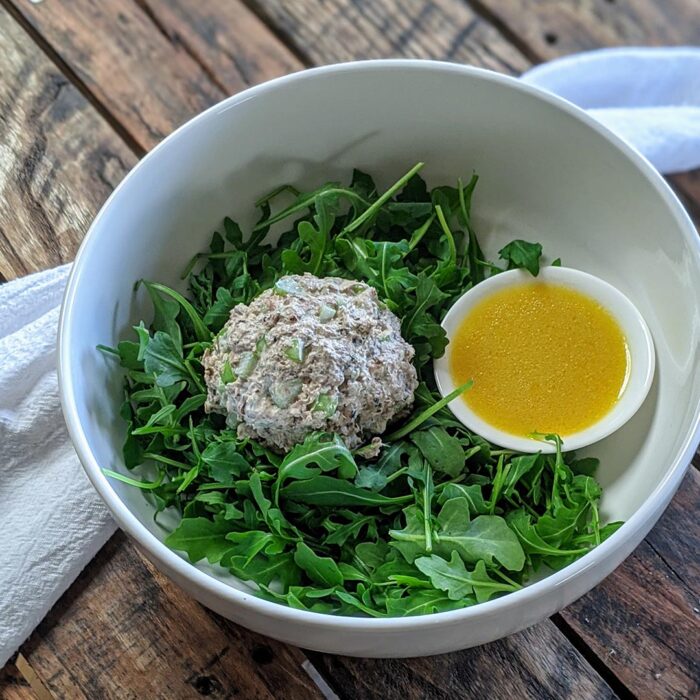





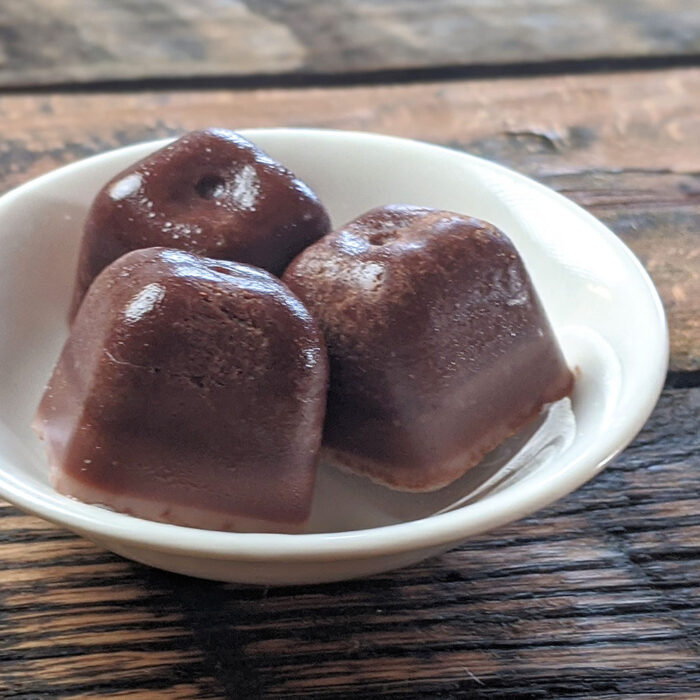
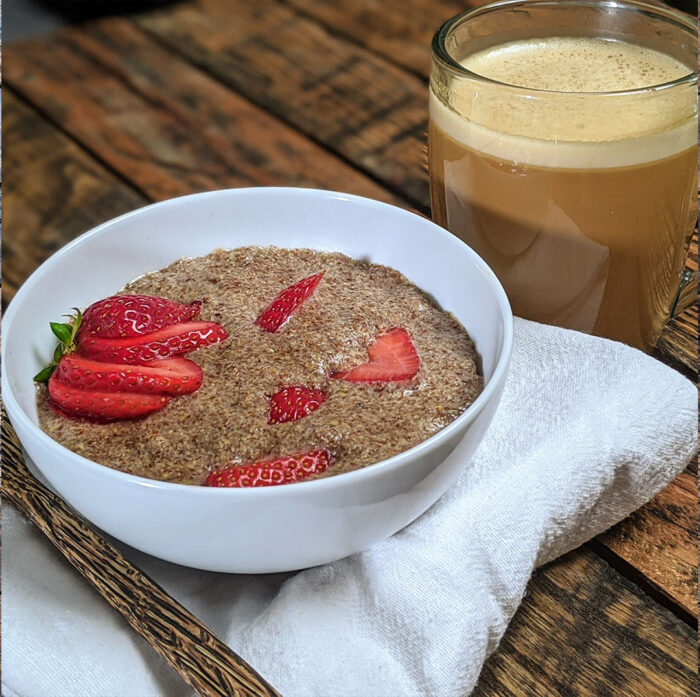


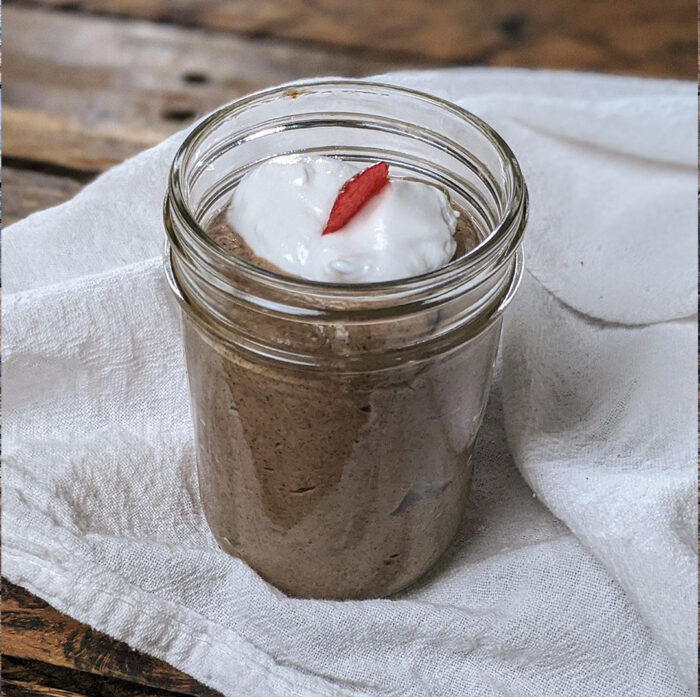
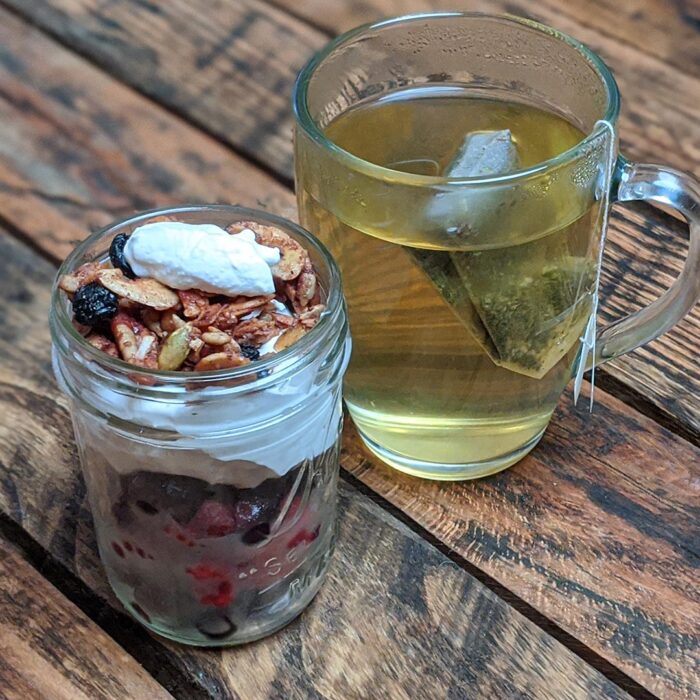
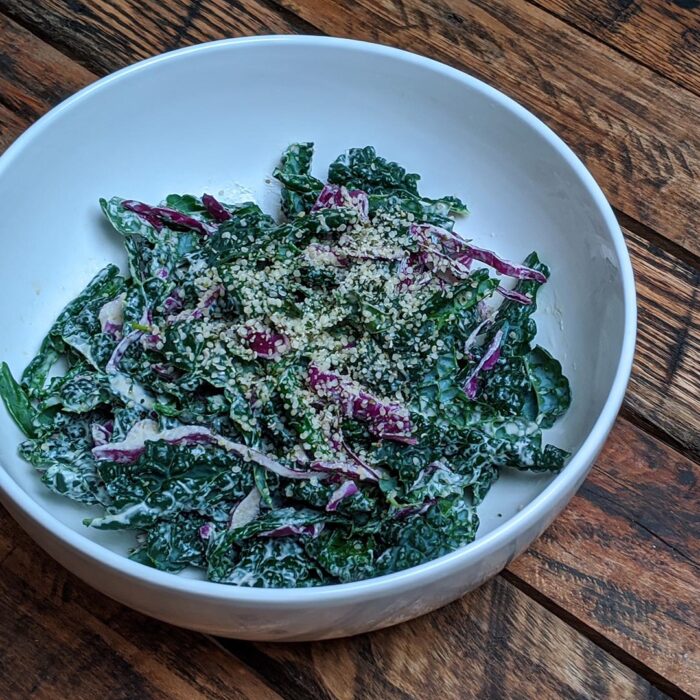

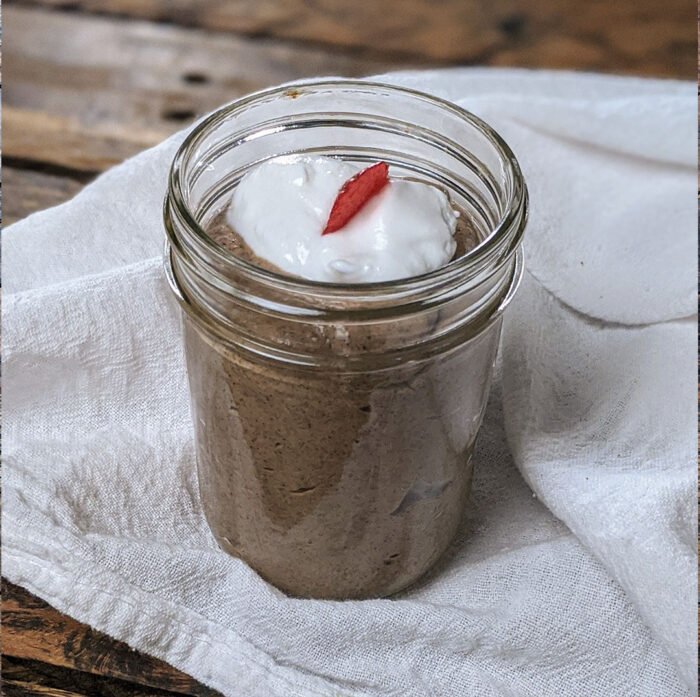
4 comments
Hi,
Where can I find the recipes and maybe extended meal plans for therapeutic keto please? Do you have a book with this infomration?
Thanks Nicole.
Hi Nicole! I’m working on exactly this and am very hopeful the book will be out mid-2022. I’ll be releasing the recipe portion first just to get it out ASAP. In the meantime, I have some recipes o this blog: https://cancerv.me/category/anti-cancer-diet/cancer-fighting-recipes/
If you’re on the mailing list you’ll get notified as soon as it’s out.
Good luck and much love!
Hi Maggie
I am so impressed and educated by your way of treating cancer as a metabolic disease and by the way you applied nutrition to fight cancer
As a medical doctor and a cancer sufferer myself , I would love to learn from you to help kill my ovarian cancer and be as healthy as ever
I have signed up for your newsletter and can’t wait to read more and learn
Hi Taysir! I’m s sorry to hear what you’re going through but am inspired by the research you’re doing now! If you haven’t already, I recommend reading The Metabolic Approach to Cancer. One of the authors, Dr. Nasha Winters, was diagnosed with stage 4 ovarian cancer when she was 19 – it had progressed to far for her to use conventional therapy. I interviewed her for our upcoming documentary last month – 30 years after her diagnosis. As difficult as it is to navigate what you’re going through now, these treatments are real and I know you’ll find healing.
Sending love!